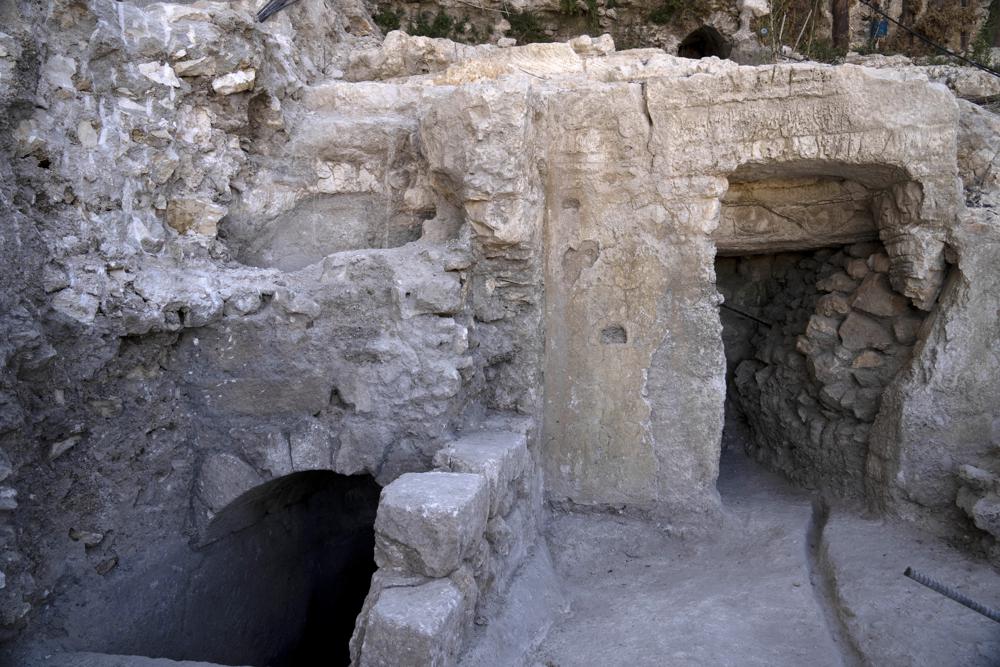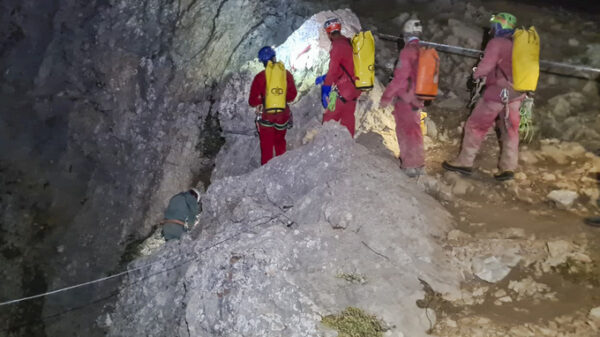The site of a Jewish ritual bath or mikveh, left, discovered near the Western Wall in the Old City of Jerusalem, Sunday, July 17, 2022. An excavation to build an accessible elevator from the Jewish Quarter to the Western Wall near the Temple Mount by the Hebrew University of Jerusalem’s Institute of Archaeology has unearthed the mikveh that dates back to the 1st Century CE. (AP Photo/Maya Alleruzzo)
JERUSALEM (AP) — Installing an elevator doesn’t normally involve a 2,000-year plunge into an ancient city’s history. But in Jerusalem, even seemingly simple construction projects can lead to archaeological endeavors.
Archaeologists from the Hebrew University of Jerusalem say they have made numerous discoveries, including an ornate first-century villa with its own ritual bath, after a project began to increase access for disabled people to Jerusalem’s Western Wall.
The villa, located footsteps from where the biblical Jewish Temples stood, was uncovered during several years of salvage excavations in the Jewish Quarter of Jerusalem’s historic Old City. Archaeologists perform salvage excavations to make a scientific study of ancient artifacts and buildings before they are removed to make way for modern construction.
Jerusalem’s Western Wall is the holiest site where Jews can pray and millions of worshipers and tourists visit it each year. But to get to the site from the adjacent Jewish Quarter, visitors typically have to descend 142 steps, or take a long detour around the city walls to one of the nearby gates.
In 2017, the Jewish Quarter Reconstruction and Development Company got the green light to begin construction of two elevators to let visitors make the 26-meter (85-foot) descent with greater ease. The location was a narrow sliver of largely undeveloped slope abutting the existing staircase on the eastern edge of the Jewish Quarter.
“The Western Wall is not a privilege, it’s elemental for a Jew or for any person from around the world who wants to come to this holy place,” said Herzl Ben Ari, CEO of the development group. “We have to enable it for everybody.”
However, like modern development projects in other ancient cities, such as Istanbul, Rome, Athens and Thessaloniki, archaeological finds slowed progress to a crawl.
“This plot of land where the elevator is going to be built remained undisturbed, giving us the great opportunity of digging through all the strata, all the layers of ancient Jerusalem,” said Michal Haber, an archaeologist from the Hebrew University of Jerusalem.
Five years into the undertaking, the archaeological work is nearing completion, but the elevators are only expected to be brought online in 2025.
During their dig, the archaeologists carefully peeled back successive layers of construction and debris that had accumulated over two millennia, over 9 meters (30 feet) in total. Historical waypoints included Ottoman pipes built into a 2,000-year-old aqueduct that supplied Jerusalem with water from springs near Bethlehem; early Islamic oil lamps; bricks stamped with the name of the 10th Legion, the Roman army that besieged, destroyed and was afterwards encamped in Jerusalem two millennia ago; and the remains of the Judean villa from the final days before the ancient Jewish Temple’s destruction in the year 70.
Archaeologist Oren Gutfeld said they were surprised to uncover traces from Jerusalem’s reconstruction as the Roman city of Aelia Capitolina in the 2nd century.
Fragments of frescoes and intricate mosaics from the villa indicated the wealth of the home’s occupants. But upon reaching bedrock, Gutfeld and Haber’s team made one last find: a private Jewish ritual bath hewn into the limestone mountainside and vaulted with enormous dressed stones.
Haber said the most significant thing about the bath, known as a mikveh, was its location overlooking the Temple esplanade.
“We are in the wealthy neighborhood of the city on the eve of its destruction,” she said.
While the elevator project is less contentious, development or archaeology excavations in Jerusalem, a city is holy to three faiths, often take on a political dimension. The Palestinians claim east Jerusalem as the capital of their hoped-for state, while Israel considers the entire city as its eternal, undivided capital.
Israel captured east Jerusalem, which includes the Old City and holy sites to Jews, Christians and Muslims, in the 1967 war. It later annexed east Jerusalem in a move unrecognized by most of the international community.
Copyright 2021 Associated Press. All rights reserved.
Source: https://apnews.com/article/science-middle-east-religion-jerusalem-d9e26b26a2046f9f19c7f83d336c015d




























